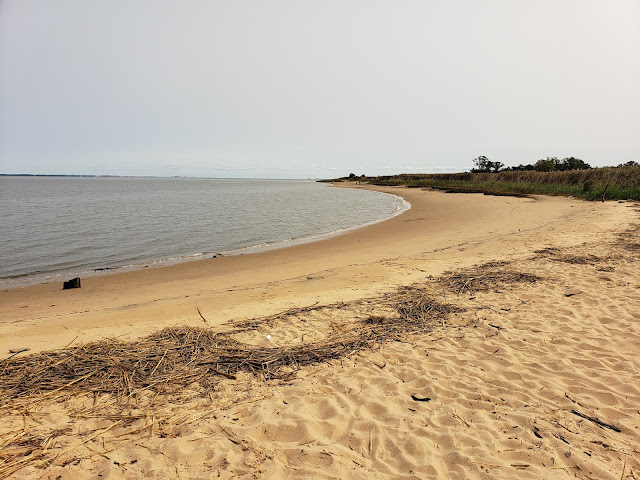Woodland Beach: A Pleasant Beach Walk at the Site of One of the First Thrill Rides
One of our favorite stops so far on the Delaware Bayshore Byway has been the little town of Woodland Beach, east of Smyrna.
 |
| Woodland Beach resort, with the hotel on the left and the steamboat Thomas Clyde in front, from a wayfinding sign at Woodland Beach Wildlife Management Area |
There were amusement park rides, too, including a merry-go-round and something called a razzle dazzle. The razzle dazzle was a large ring suspended by wires from a central pole. Patrons sat on the ring, and staff pushed the ring to rotate it around the pole and also push it up and down. This was one of the first amusement park rides that rotated and tilted simultaneously.
 |
| The razzle dazzle ride at Coney Island |
The photo below, from the Art Gallery of New South Wales, Australia, shows a razzle dazzle in action. Notice that patrons face inward, so they’d be moving sideways, and of course there were no seatbelts! So even though it wasn’t motorized, it was one of the first—if not the first—“white knuckle” rides. Today plenty of amusement parks still have a motorized version of the razzle dazzle, often called the trabant.
 |
| Razzle dazzle in Australia, photographed by Harold Cazneaux in 1910 |
Some websites say Woodland Beach had a roller coaster, but I wonder if they're referring to the razzle dazzle. While roller coasters and razzle dazzles are designed completely differently, the thrilling effect of simultaneous turning and tilting is very similar.
Woodland Beach was hit in 1878 by the same hurricane storm surge that destroyed the Collins Beach resort a few miles north. The land around Woodland Beach didn’t erode as much as that around Collins Beach, so the resort was able to rebuild. But another storm in 1914 destroyed the resort for good.
Today Woodland Beach is a community with a few dozen homes spread over a couple of blocks. A few houses are from the early 1900s, but most were built in the 20th century after the resort was destroyed.
 |
| Houses at Woodland Beach |
At low tide the beach is one of the largest we’ve seen so far on the Delaware Bay, very clean, and great for walking.
 |
| Woodland Beach beachfront |
The beach is completely submerged at high tide, so check the tide schedule before you visit.
 |
| High tide line right against marsh grasses |
I’d read that Woodland Beach is a great place to hunt for sea glass, but I didn’t see any. A couple I met on our walk said that they hadn’t seen any sea glass for a few years. But if you like to hunt for pebbles, there are plenty of pretty ones here.
 |
| Pebbles at Woodland Beach |
Woodland Beach also has a really nice fishing pier, lit and open 24 hours.
 |
| Woodland Beach fishing pier |
Until very recently, there was an old building at 100 Beach Avenue—right next to the parking lot—that once housed a crab house called Blendt’s. There were plans to rehab it into a restaurant called Croaker’s a few years ago, but those plans fell through and the lot was sold. The building is now gone, and during our visit something was under construction there.
 |
| 100 Beach Avenue, former site of Blendt's restaurant |
A few tips before you visit Woodland Beach:
- We had a great visit in mid-September, but I've read that mosquitos and horse flies can get really bad in summer.
- There's a good-sized parking lot with a sign that there is no overflow parking. In other words, if the parking lot is full, visit another beach.
- There's a portapotty in the parking lot.
This web page has some more old photos of Woodland Beach. And this Smyrna news archive has more information on the history of Woodland Beach. Scroll down to the heading “Blendt donates painting to Smyrna museum.”




My grandparents lived in the house at 88 Beach Ave; the house right on the water. They sold it a few years back and the new owners tore it down. My grandparents had built it by hand and lived there most of their life!
ReplyDeleteWhat a great story! I can't imagine building a house by hand. So sorry to hear that it's gone now.
Delete